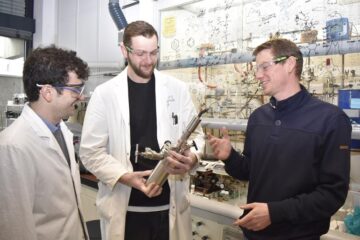Rethinking Renewables: A New Approach to Energy Storage for Wind and Solar

Researchers at Rensselaer Polytechnic Institute are leading a new $2 million study to help overcome a key bottleneck slowing the proliferation of large-scale wind and solar power generation.
Funded by a $2 million grant from the U.S. National Science Foundation, the four-year study aims to develop novel ceramic materials for use in a new approach to energy storage. Rather than batteries, the researchers will develop nanostructured capacitors to store energy that is generated and converted by wind turbines and solar panels. With an extremely high power density and the ability to very quickly charge and discharge, these nanoengineered capacitors could be a game-changer impacting a wide range of applications, from energy production to electronics to national defense.
“The transformative nature of capacitive energy storage – a totally new approach to energy storage – will have a tremendous impact on the increased use and efficiency of wind and solar power, as well as conventional coal, nuclear, and hydroelectric generation,” said Doug Chrisey, professor in the Department of Materials Science and Engineering at Rensselaer, who is leading the study. “Our proposed capacitors will be smaller, lighter, and more efficient than today’s batteries, and with no moving parts the capacitors should last forever. Everyone is looking for a truly innovative material to help meet future energy requirements, and we’re confident that our novel ceramic will help advance that conversation.”
The grant was awarded through the NSF Emerging Frontiers in Research and Innovation (EFRI) Program, overseen by the NSF Engineering Directorate, which identifies and supports interdisciplinary initiatives at the emerging frontier of engineering research and education. For the study, Chrisey is partnering with renowned glass expert and Rensselaer Professor Minoru Tomozawa, along with nanoscientist and University of Puerto Rico, Río Piedras Professor Ram S. Katiyar.
Unlike a battery, which supplies a continuous level of low power for long periods of time, a capacitor moves large amounts of power very quickly. The ideal solution for electrical energy storage, Chrisey said, will allow fast energy storage and discharge in as small a volume or mass as possible. To achieve this, the researchers will develop a nanostructured capacitor comprising extremely thin layers of a novel composite. The composite is a mix of ferroelectric nanopowder and low-melting, alkali-free glass. The result is a capacitor that can withstand high electric fields and maintain an extremely high dielectric constant – two critical metrics for measuring the effectiveness of energy storage materials.
In addition to optimizing and perfecting the composition of the novel ceramic material, Chrisey and team are tasked with developing new processes to make the material easily and in large quantities.
“Creating a novel ceramic material and developing a cost-effective, scalable method to achieve large-capacitive energy storage could be a big boost to our national economy and increase our global competitiveness,” Chrisey said. “What we need is an entirely new approach to energy storage, and we think ferroelectric glass composites could be the answer.”
For more information on Chrisey and his research at Rensselaer, visit:
http://mse.rpi.edu/faculty_details.cfm?facultyID=chrisd
Contact
Michael Mullaney
Rensselaer Polytechnic Institute
Troy, NY
518-276-6161
mullam@rpi.edu
www.rpi.edu/news
Visit the Rensselaer research and discovery blog: http://approach.rpi.edu
Follow us on Twitter: www.twitter.com/RPInews
Media Contact
More Information:
http://www.rpi.edu/newsAll latest news from the category: Power and Electrical Engineering
This topic covers issues related to energy generation, conversion, transportation and consumption and how the industry is addressing the challenge of energy efficiency in general.
innovations-report provides in-depth and informative reports and articles on subjects ranging from wind energy, fuel cell technology, solar energy, geothermal energy, petroleum, gas, nuclear engineering, alternative energy and energy efficiency to fusion, hydrogen and superconductor technologies.
Newest articles

Lower dose of mpox vaccine is safe
… and generates six-week antibody response equivalent to standard regimen. Study highlights need for defined markers of mpox immunity to inform public health use. A dose-sparing intradermal mpox vaccination regimen…

Efficient, sustainable and cost-effective hybrid energy storage system for modern power grids
EU project HyFlow: Over three years of research, the consortium of the EU project HyFlow has successfully developed a highly efficient, sustainable, and cost-effective hybrid energy storage system (HESS) that…

Safer alternative for an explosive reaction
The chemical industry has been using a reaction with explosive chemicals for over 100 years – now Mülheim scientists have discovered a safer alternative. The Ritter Group of the Max…





















